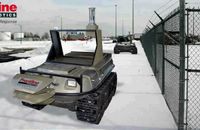Robots Cooperate for Social Good
Robotic leader makes for good teamwork
Philip Ball
When two robots arrive at a doorway, who should go first?
Robots are terribly polite these days. When two vehicles developed by a Canadian robotics firm arrive at a narrow door at the same time, they have a friendly way to decide who should pass through first.
The key is to use a team of robots with an elected leader who makes decisions that are best for the group as a whole. Representatives from the Ottawa-based company Frontline Robotics, who will present their polite robots at the RoboBusiness robotics conference in Cambridge, Massachusetts, this May, say their software should be ideal for a variety of military and civilian applications.
Many researchers are seeking to develop robots that work in packs, coordinating their actions in response to one another. This way of working, called distributed intelligence, resembles the way that social insects such as ants or bees collaborate in foraging or nest building.
It has been shown that such groups can evolve problem-solving strategies that are more efficient than those in which each robot acts independently.
But the robots in such groups usually don't make decisions; they simply respond in a programmed way to a set of input signals. The collaboration between Frontline's robots is different: two robots facing a doorway have to be slightly more flexible.
Who goes first
Frontline's software, called Robotic Open Control (ROC), operates by first allowing the robots to elect a leader. At potential 'choke' points such as a narrow door, the leader is called upon to make decisions.
Each robot applies to the leader for permission to pass through the door, and, by sifting through a prescribed set of rules, the leader decides to award a pass token to one robot by radio signal, allowing it to move forwards. If the leader is somehow put out of action, the team elects another.
The tricky bit is ensuring that the rules about who should go first actually narrow down one winner in each case. The software has been designed to ensure that "progress toward objectives is guaranteed" and that the robots don't get stuck in conflicting reasoning cycles.
Wheelie smart
For the moment, Frontline has put their software into commercially available, four-wheeled rover vehicles, making what they call unmanned ground units or GRUNTs.

Grunts on patrol
At just over a 2 metres long and weighing 450 kilograms, GRUNTs can reach speeds of 30 kilometres per hour and can spin on the spot twice in one second. They are fitted with radio communication systems, all-around imaging cameras, night-vision sensors, radar, and navigation that uses the Global Positioning System (GPS).
news @ nature.com�-�Robotic leader makes for good teamwork �-�When two robots arrive at a doorway, who should go first?
Philip Ball
When two robots arrive at a doorway, who should go first?
Robots are terribly polite these days. When two vehicles developed by a Canadian robotics firm arrive at a narrow door at the same time, they have a friendly way to decide who should pass through first.
The key is to use a team of robots with an elected leader who makes decisions that are best for the group as a whole. Representatives from the Ottawa-based company Frontline Robotics, who will present their polite robots at the RoboBusiness robotics conference in Cambridge, Massachusetts, this May, say their software should be ideal for a variety of military and civilian applications.
Many researchers are seeking to develop robots that work in packs, coordinating their actions in response to one another. This way of working, called distributed intelligence, resembles the way that social insects such as ants or bees collaborate in foraging or nest building.
It has been shown that such groups can evolve problem-solving strategies that are more efficient than those in which each robot acts independently.
But the robots in such groups usually don't make decisions; they simply respond in a programmed way to a set of input signals. The collaboration between Frontline's robots is different: two robots facing a doorway have to be slightly more flexible.
Who goes first
Frontline's software, called Robotic Open Control (ROC), operates by first allowing the robots to elect a leader. At potential 'choke' points such as a narrow door, the leader is called upon to make decisions.
Each robot applies to the leader for permission to pass through the door, and, by sifting through a prescribed set of rules, the leader decides to award a pass token to one robot by radio signal, allowing it to move forwards. If the leader is somehow put out of action, the team elects another.
The tricky bit is ensuring that the rules about who should go first actually narrow down one winner in each case. The software has been designed to ensure that "progress toward objectives is guaranteed" and that the robots don't get stuck in conflicting reasoning cycles.
Wheelie smart
For the moment, Frontline has put their software into commercially available, four-wheeled rover vehicles, making what they call unmanned ground units or GRUNTs.

Grunts on patrol
At just over a 2 metres long and weighing 450 kilograms, GRUNTs can reach speeds of 30 kilometres per hour and can spin on the spot twice in one second. They are fitted with radio communication systems, all-around imaging cameras, night-vision sensors, radar, and navigation that uses the Global Positioning System (GPS).
news @ nature.com�-�Robotic leader makes for good teamwork �-�When two robots arrive at a doorway, who should go first?

0 Comments:
Post a Comment
Subscribe to Post Comments [Atom]
<< Home